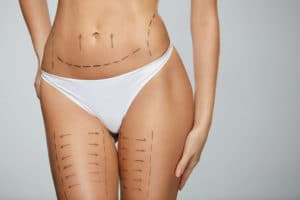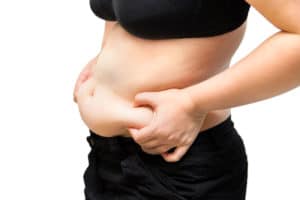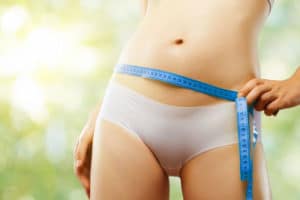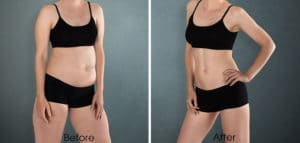When did they start this procedure?
 Although the first known use of suction to remove fat from the body was performed by French surgeon Charles Dujarier in the 1920s, the development of modern liposuction is credited to father and son Italian gynecologists Arpad and Giorgio Fischer who in 1974 invented a blunt, hollow surgical instrument called a cannula that allowed them to create tunnels between major blood vessels of the body while sucking out fat.
Although the first known use of suction to remove fat from the body was performed by French surgeon Charles Dujarier in the 1920s, the development of modern liposuction is credited to father and son Italian gynecologists Arpad and Giorgio Fischer who in 1974 invented a blunt, hollow surgical instrument called a cannula that allowed them to create tunnels between major blood vessels of the body while sucking out fat.
Prior to this time, many physicians had attempted to sculpt fat build-up using a curette, a surgical tool designed for scraping, which often caused blood clots, abscesses, skin unevenness, and other health complications. Other doctors of the era tried to reshape the body by surgically removing both fat and skin, resulting in unsightly scarring, and with time, re-accumulation of fat around the incision sites leading to physical deformity.
By 1978- Recognizing the potential impact of this new procedure, Illouz popularized it throughout France, gradually developing the so-called “wet technique” in which a solution of saline (salt water) was injected into the fat before suctioning to decrease bleeding and make suctioning easier. A short time later, Fournier introduced the use of the local anesthetic lidocaine, laying the groundwork for the tumescent technique used today.
By 1980, “lipo” had become quite popular in the US but met with a great deal of negative publicity due to many patients experiencing excessive bleeding and tell-tale rippling of the skin after surgery. Finally, in 1985, California dermatologist Dr. Jeffrey A. Klein revolutionized liposuction by perfecting the tumescent technique, a method by which both lidocaine and epinephrine (a drug that shrinks capillaries), are injected into the fat. With his more refined method, patients could have liposuction performed completely under local anesthesia using a much smaller cannula without fear of excessive bleeding or undesirable skin depressions. It quickly became the most popular means of shaping the body, especially for women’s buttocks and thighs.
Though considered by some to be a technology apart from traditional liposuction, Power-Assisted Lipoplasty, approved for general use in 1998, uses a special cannula that pulses as it suctions. While not yet widely used, many modern plastic surgeons believe that it, like Ultrasound-Assisted Lipoplasty, may offer as yet unknown possibilities in the near future.
What is this procedure?
Liposuction, sometimes referred to as “lipo” by patients, slims and reshapes specific areas of the body by removing excess fat deposits and improving your body contours and proportion.
Liposuction is a surgical procedure that uses a suction technique to remove fat from specific areas of the body, such as the abdomen, hips, thighs, buttocks, arms or neck. Liposuction also shapes (contours) these areas. Other names for liposuction include Lipoplasty and body contouring.
Liposuction isn’t typically considered an overall weight-loss method or a weight-loss alternative. If you’re overweight, you’re likely to lose more weight through diet and exercise or through bariatric procedures — such as gastric bypass surgery — than you would with liposuction. You may be a candidate for liposuction if you have too much body fat in specific spots but otherwise have a stable body weight.
This is the name given to the surgical procedure which removes pockets of fat from the body. Fat distribution is determined by our genetic structure as well as our lifestyles. Following a sensible diet and exercise plan can reduce our body fat levels but sometimes, stubborn areas remain, in spite of a healthy lifestyle.
Liposuction involves the insertion of a series of small, thin tubes or cannulas which are connected to a large suction syringe or vacuum pump. Fluid is injected into the areas to be removed which helps to prevent blood loss. Each cannula is inserted in such a way which breaks down the fat cells which are then suctioned out via the vacuum pump or suction syringe. Several areas can be done at once and liposuction can be undertaken with other cosmetic procedures.
Who needs this procedure?
In general, good candidates for a liposuction include:
- Adults within 30% of their ideal weight who have firm, elastic skin and good muscle tone
- Healthy individuals who do not have a life-threatening illness or medical conditions that can impair healing
- Nonsmokers
- Individuals with a positive outlook and specific goals in mind for body contouring
If you are bothered by excess fat deposits located anywhere on your body that don’t respond to diet or exercise, liposuction may be right for you.
What is the advantage of this procedure?
Liposuction is used to remove fat from areas of the body that haven’t responded to diet and exercise, such as the: Abdomen, Upper arms, Buttocks, Calves and ankles, Chest and back, Hips and thighs, Chin and neck.
In addition, liposuction can sometimes be used for breast reduction or treatment of gynecomastia. When you gain weight, fat cells increase in size and volume. In turn, liposuction reduces the number of fat cells in a specific area. The amount of fat removed depends on the appearance of the area and the volume of fat. The resulting contour changes are generally permanent — as long as your weight remains stable.
After liposuction, the skin molds itself to the new contours of the treated areas. If you have good skin tone and elasticity, the skin is likely to appear smooth. If your skin is thin with poor elasticity, however, the skin in the treated areas may appear loose.
Liposuction doesn’t improve cellulite dimpling or other skin surface irregularities. Likewise, liposuction doesn’t remove stretch marks.
To be a candidate for liposuction, you must be in good health without conditions that could complicate surgery — such as restricted blood flow, coronary artery disease, diabetes or a weak immune system.
Are there non-surgical treatments?

Local anesthesia helps to minimize the hassle of small surgical procedures for patients. It reduces the necessary preparation, side effects, and downtime from surgery.
The local anesthesia use is a two-step process. I first inject the access incision sites with concentrated lidocaine. The needle is tiny and relatively painless. Once numb, I infuse a large amount of dilute local anesthesia solution into the fatty layers of tissue. I usually chat with the patient during this process so that they’re distracted. Most patients report afterward that they found the process easy and tolerable. My extensive experience is very helpful in making this a smooth process for my patients.
What is the surgical treatment like local or sedation?
Some liposuction procedures may require only local or regional anesthesia — anesthesia limited to a specific area of your body. Other procedures may require general anesthesia, which induces a temporary state of unconsciousness. You may be given a sedative, typically through an IV injection, to help you remain calm and relaxed.
The surgical team will monitor your heart rate, blood pressure and blood oxygen level throughout the procedure. If you are given local anesthesia and feel pain during the procedure, tell your surgeon. The medication or motions may need adjustment.
The procedure may last up to several hours, depending on the extent of fat removal.
If you’ve had general anesthesia, you’ll wake in a recovery room. You’ll typically spend at least a few hours in the hospital or clinic so that medical personnel can monitor your recovery. If you’re in a hospital, you may stay overnight to make sure that you’re not dehydrated or in shock from fluid loss.
What is the recovery like?
Expect some pain, swelling and bruising after the procedure. Your surgeon may prescribe medication to help control the pain and antibiotics to reduce the risk of infection.
After the procedure, the surgeon may leave your incisions open and place temporary drains to promote fluid drainage. You usually need to wear tight compression garments, which help reduce swelling, for a few weeks.
You may need to wait a few days before returning to work and a few weeks before resuming your normal activities — including exercise. During this time, expect some contour irregularities as the remaining fat settles into position. Incisions will be dressed with small bandages. The treated area will be wrapped with a compression garment. Pain medication will be prescribed to ease any swelling and discomfort. Our Recovery Protocol, which includes supplements, vitamins, and anti-bruising medications, will begin.
1 WEEK- Patients are usually able to return to work and light activities. Active stretching is advised. Swelling and bruising will begin to resolve.
2 WEEKS- Massages and light physical activities geared to avoid injury will be allowed. Strenuous exercise and heavy lifting should be avoided.
4 TO 6 WEEKS- Results will be more apparent. Patients may return to their normal activities, including strenuous exercise and lifting, once cleared by Dr. Chiu.
6 MONTHS- All residual swelling will have resolved. Final results will be apparent, though tightening of the tissues will continue for the rest of the year.
How long does it take?
Liposuction procedure takes around 60-180 minutes depending on the degree of correction required.
What are the complications?
Liposuction risks include:
- Anesthesia risks
- Bruising
- Change in skin sensation that may persist
- Damage to deeper structures such as nerves, blood vessels, muscles, lungs and abdominal organs
- Deep vein thrombosis, cardiac and pulmonary complications
- Fluid accumulation
- Infection
- Irregular contours or asymmetries
- Irregular pigmentation
- Need for revision surgery
- Persistent swelling
- Poor wound healing
- Rippling or loose skin, worsening of cellulite
- Swelling
- Thermal burn or heat injury from ultrasound with the ultrasound-assisted lipoplasty technique
These risks and others will be fully discussed prior to your consent. It is important that you address all your questions directly with your plastic surgeon. Secondary procedures may sometimes be recommended to reduce excess skin. Special considerations are needed when large amounts—usually more than five liters of fat—are suctioned. As with any major surgery, liposuction carries risks, such as bleeding and a reaction to anesthesia. Possible complications specific to liposuction include:
Contour irregularities. Your skin may appear bumpy, wavy or withered due to uneven fat removal, poor skin elasticity and unusual healing. These changes may be permanent. Damage beneath the skin from the thin tube (cannula) that’s used during liposuction may give the skin a permanent spotted appearance.
Fluid accumulation. Temporary pockets of fluid (seromas) can form under the skin. This fluid may need to be drained with a needle.
Numbness. You may feel temporary or permanent numbness in the affected area. Temporary nerve irritation also is possible.
Infection. Skin infections are rare but possible. A severe skin infection may be life-threatening.
Internal puncture. Rarely, a cannula that penetrates too deeply may puncture an internal organ. This may require emergency surgical repair.
Fat embolism. Pieces of loosened fat may break away and become trapped in a blood vessel and gather in the lungs or travel to the brain. A fat embolism is a medical emergency.
Kidney and heart problems. Shifts in fluid levels as fluids are being injected and suctioned out can cause potentially life-threatening kidney, heart and lung problems.
Lidocaine toxicity. Lidocaine is an anesthetic often administered with fluids injected during liposuction to help manage pain. Although generally safe, in rare circumstances, lidocaine toxicity can occur, causing serious heart and central nervous system problems.
The risk of complications increases if the surgeon is working on larger surfaces of your body or doing multiple procedures during the same operation. Talk to your surgeon about how these risks apply to you.
What can you do to speed up recovery?

Instead of merely lying around and waiting for time to heal your surgical wounds, engage in some simple proactive tools to help the recovery process:
-
- Diet – eating well for recovery.
Reduce salt. Salt encourages our body to retain water, so get rid of unwanted swelling by eating foods that are low in sodium.
No Gatorade. It may seem counterintuitive, but the sports drink is filled with sodium encouraging water retention.
Increase protein. Protein is essential with wound healing, muscle and skin re-growth and repair and prevention of hair loss. Make sure that every meal or snack includes a good source of protein.
Decrease Sugar. The intake of sugar can suppress the immune system, upset the body’s mineral balance, and increase fasting levels of blood glucose.
Eat small amounts many times throughout the day. – Especially to avoid nausea and bloating.
Wine works as a diuretic, so consuming a glass of wine 2-3 weeks post-operatively may be helpful for post-surgical swelling. Do not mix alcohol with any prescription drugs and consult with your physician first.
Consume a quality probiotic. Antibiotics and other prescription drugs will destroy good bacterial in our gut. We recommend Inner-Eco – a fresh coconut water probiotic.
- Diet – eating well for recovery.
-
- Walk – increase circulation and the flow of lymph fluid. Rest for the first 24 hours, and then slowly get back into your normal daily activities as tolerated. In the early stages of post-surgical recovery many physicians request that heart rate is not to be elevated. We suggest walking in your neighborhood or mall at a normal shopping pace – not an exercise pace. You can do this without raising your heart rate for any length of time. Quit if you experience fatigue, dizziness or experience nausea.
-
- Hydration – drink low-calorie, non-carbonated beverages.
We suggest Water, Skim Milk, Diet Nestea, Diet V-8 Splash, Tea, Diluted Fruit Juice (about 4 oz. /day), Flavored water (i.e. Propel) and Crystal Light. – stay away from Gatorade due to high levels of sodium
Watermelon. In addition to this tasty fruit there are a number of high water content fruits and vegetables including strawberries, grapefruit, zucchini and celery.
- Hydration – drink low-calorie, non-carbonated beverages.
-
- Rest – listening to the needs of your body. A week or so after your surgery your conscious mind may be telling you that you ‘should’ be getting back to your ‘normal’ life. Remember that your body’s acting in a trauma mode for 6 weeks following the surgery. Heed what it’s telling you to do. Sleep if it says that you’re tired, eat if you experience hunger pains and drink if you feel thirsty.
-
- Soulstice Peri-operative Therapy – our integrated manual post-operative techniques.
Lymph Drainage. Reduces unwanted and unneeded post surgical swelling.
Fascial Reorganization. Reduces lumps, bumps, tightened connective tissue and muscle.
Facilitated Stretching. Aids and guides patients back to proper mobility and function.
Scar Manipulation. Combats scar thickening and normalizes soft tissue.
Stress Reduction. Calms the nervous system and alleviates post-op depression and ‘buyer’s remorse’.
- Soulstice Peri-operative Therapy – our integrated manual post-operative techniques.
-
- Clothing – knowing what to wear.
Itching. Consider using a men’s basic tank top underneath your compression garment for itching issues. These t-shirts are nice and snug and conform to the body, unlike a regular t-shirt would. Don’t hesitate to cut to size.
Drain Holders. Consider attaching shoe strings to your drains to help in the shower.
No Tight Waistbands. Avoid wearing anything that’s binding in the midsection following a lipo procedure. That includes elastic waistbands and belts.
Compression Garments. If you’ve been directed to wear one, be sure to purchase two, so that you can wash one while wearing the other. When garments become loose remember that they’re not working anymore. After your physician says you can stop wearing a compression garment, some patients still choose to wear it for support and comfort.
- Clothing – knowing what to wear.
-
- Stretching
Large Exercise Ball. Use to stretch post-surgically and break up adhesions (great after lipo procedures) Rotate in all directions. Lay on back, sides and stomach. - Self Massage – in between treatments at Soulstice.
Mechanical Massage Units. Great for ‘at home’ self massage – especially for tummy tuck and lipo procedures. Be sure to find one that adjusts for intensity and remember your numbness will not give you an accurate sense of how deep it’s working. Back off, and remember that in this situation less-is-more. Consider using at 6 weeks post op and beyond.
- Stretching
-
- Scar Care
How to minimize a scar. There are many ideas as to decreasing the size of a surgical scar. We’ve discovered that the applicator, a.k.a. your finger(s), is the most effective tool to help minimize your scar. The act of ‘rubbing’ the scar is the best way to stimulate blood flow, and increase the flow of skin-rejuvenating oxygen and nutrients.
Ointments. Some of these include vitamin C, silicone dressing, or Mederma scar cream. While these may or may not be effective, we have found that applying a thin layer of petroleum jelly on a completely closed and sealed scar, and covering with an adhesive bandage, is the best way to minimize the appearance, feel, and look of a scar.
Silicone Sheeting. Helps to keep a scar warm and moist, therefore aids in scar healing.
Sunscreen! Newly formed scar tissue has no pigmentation. Avoid sun exposure on your scar for a minimum of one year after your surgery. Sun exposure on scars may cause permanent discoloration. A stick sunscreen will provide the most protection. Alternatively, a sunscreen lotion with a minimum of SPF 15, broad-spectrum protection and Parsol 1789 is also acceptable. Be sure to check with your physician for their particular sun screen recommendations.
- Scar Care
- Itching- Anti-itch Lotion. This product may be found at a local drugstore.
Do you need to rest up afterwards and for how many days?
During your liposuction recovery, a compression garment or elastic bandages may cover treatment areas once your procedure is completed. These help to control swelling and compress the skin to your new body contours. In addition, small temporary drains may be placed in existing incisions beneath the skin to remove any excess blood or fluid.
You will be given specific instructions that may include:
- How to care for the surgical site and drains
- Medications to apply or take orally to aid healing and reduce the potential for infection
- Specific concerns to look for at the surgical site or in your general health
- When to follow up with your plastic surgeon
Be sure to ask your plastic surgeon specific questions about what you can expect during your individual recovery period:
- Where will I be taken after my surgery is complete?
- What medication will I be given or prescribed after surgery?
- Will I have dressings/bandages after surgery?
- How long will I wear the compression garment?
- Are stitches removed? When?
- When can I resume normal activity and exercise?
- When do I return for follow-up care?
It may take several months for the swelling to fully dissipate. As it does, your new contours and enhanced self-image should continue to develop.
Before & After Gallery

